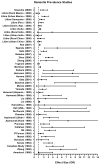Relationship between education and dementia: an updated systematic review
- PMID: 21750453
- PMCID: PMC3193875
- DOI: 10.1097/WAD.0b013e318211c83c
Relationship between education and dementia: an updated systematic review
Abstract
Objective: The purpose of this study was to review the relationship between education and dementia.
Methods: A systematic literature review was conducted of all published studies examining the relationship between education and dementia listed in the PubMed and PsycINFO databases from January 1985 to July 2010. The inclusion criteria were a measure of education and a dementia diagnosis by a standardized diagnostic procedure. Alzheimer disease and Total Dementia were the outcomes.
Results: A total of 88 study populations from 71 studies met inclusion criteria. Overall, 51 studies (58%) reported significant effects of lower education on risk for dementia, whereas 37 studies (42%) reported no significant relationship. A relationship between education and risk for dementia was more consistent in developed regions compared with developing regions. Age, sex, race/ethnicity, and geographical region moderated the relationship.
Conclusions: Lower education was associated with a greater risk for dementia in many but not all studies. The level of education associated with risk for dementia varied by study population and more years of education did not uniformly attenuate the risk for dementia. It seemed that a more consistent relationship with dementia occurred when years of education reflected cognitive capacity, suggesting that the effect of education on risk for dementia may be best evaluated within the context of a lifespan developmental model.
Figures






References
-
- Mortimer JA. Do psychosocial risk factors contribute to Alzheimer’s disease? In: Henderson AS, Henderson JH, editors. Etiology of Dementia of the Alzheimer’s Type. New York: John Wiley & Sons; 1988. pp. 39–52.
-
- Zhang M, Katzman R, Salmon DP, et al. The prevalence of dementia and Alzheimer’s disease in Shanghai China: impact of age, gender, and education. Ann Neurol. 1990;27:428–437. - PubMed
-
- Katzman R. Education and the prevalence of dementia and Alzheimer’s disease. Neurology. 1993;43:13–20. - PubMed
-
- Mortimer JA, Graves AB. Education and other socioeconomic determinants of dementia and Alzheimer’s disease. Neurology. 1993;43:S39–S44. - PubMed
-
- Gilleard CJ. Education and Alzheimer’s disease: a review of recent international epidemiology studies. Aging Ment Health. 1997;1:33–46.
Publication types
MeSH terms
Grants and funding
LinkOut - more resources
Full Text Sources
Medical
Miscellaneous

